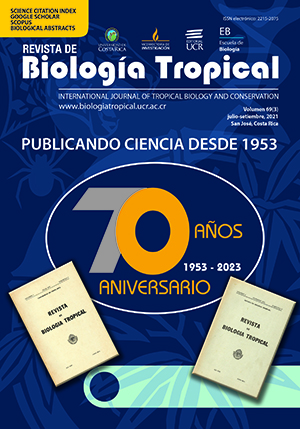Abstract
Introduction: The middle basin of the Bogotá River has been suffering from heavy metal contamination due to industrial discharges. This water source has been used to irrigate short-cycle crops, which has resulted in heavy metal contamination of productive soils. Objective: To evaluate a phytoremediation process with the plant species Broccoli (Brassica oleracea var. Italica plenck) and Cilantro (Coriandrum sativum L.) in soils contaminated with heavy metals in Mosquera, Colombia. Methods: Sampling was performed with a completely randomized factorial design: a) cilantro/broccoli proportions (30 cilantro/70 broccoli, 50/50, 70 cilantro/30 broccoli and two monoculture type controls of each species) and b) phytoremediation time (3, 6 and 9 months), each treatment with four experimental plots. Soil and plant tissue were analyzed in the laboratory by atomic absorption spectrophotometry to determine the concentration of heavy metals. Results: The analysis of heavy metals through of a spectrophotometric technique such as atomic absorption allowed the acquisition of data on concentrations, variations in relation to pH, movement of metals from soils to plant tissues and bioavailability in terms of concentration in bioaccumulator species such as Broccoli and Cilantro. In addition, the correlation matrices, and p-values lower than 0.05 allowed us to show significant data. Conclusions: Phytoremediation by means of Brassica oleracea var. Italica plenck and Coriandrum sativum L in 70/30 or 30/70 proportions in soils with pH between 5.5 and 6.0 allows a good recovery of soils with heavy metal contents in terms of high concentrations in short terms, starting bioremediation after three months and ending loads of variable availability after nine months.
Result: The analysis of heavy metals by means of a spectrophotometric technique such as atomic absorption allowed the acquisition of data on concentrations, variations in relation to pH, movements of metals from soils to plant tissues and bioavailability in terms of concentration in bioaccumulative species. such as Broccoli and Cilantro. Additionally, correlation matrices and p-values less than 0.05 allow evidence of significance data.
Conclusions: Phytoremediation by means of the species Brassica oleracea var. Italica plenck and Coriandrum sativum L in proportions 70/30 or 30/70 to soils with a pH between 5.5 and 6.0 allow a good recovery of soils with heavy metal content in terms of high concentrations in the short term, initiating bioremediation at the three months and ending variable availability loads after nine months.
References
Beltrán-Pineda, M. E., & Gómez-Rodríguez, A. M. (2016). Biorremediación de metales pesados cadmio (Cd), cromo (Cr) y mercurio (Hg), mecanismos bioquímicos e ingeniería genética: una revisión. Revista Facultad de Ciencias Básicas, 12(2), 172–197.
Combariza, D. (2009). Contaminación por metales pesados en el embalse del Muña y su relación con los niveles en sangre de plomo, mercurio y cadmio y alteraciones de salud en los habitantes del municipio de Sibaté-Cundinamarca (Tesis de Maestría). Universidad Nacional de Colombia, Colombia.
Corporación Autónoma Regional. (2006). Objetivos de calidad de agua para la cuenca del río Bogotá a lograr en el año 2020. Corporación Autónoma Regional de Cundinamarca.
Cristaldi, A., Conti, G., Jho, E., Zuccarelo, P., Grasso, A., Copat, C., & Ferrante, M. (2017). Phytoremediation of contaminated soils by heavy metals and PAHs. A brief review. Environmental Technology & Innovation, 8(2017), 309–326.
Delgadillo-López, A. E., González-Ramírez, C. A., Prieto-García, F., Villagómez-Ibarra, J. R., & Acevedo-Sandoval, O. (2011). Fitorremediación: una alternativa para eliminar la contaminación. Tropical and Subtropical Agroecosystems, 14(2), 597–612.
Fernández, W., Oyuela, M., & Gutiérrez, M. (2017). Native herbaceous plant species with potential use in phytoremediation of heavy metals, spotlight on wetlands-A review. Chemophere, 168(2017), 1230–1247.
Fundación de Asesorías para el Sector Rural Ciudad de Dios. (2021). Metodología de análisis de Laboratorio-Fundación de Asesorías para el Sector Rural. FUNDASES.
Ghosh, M., & Singh, S. (2005). A review on phytoremediation of heavy metals and utilization of it´s by products. Applied Ecology and Environmental Research, 3(1), 1–18.
González-Mendoza, D., & Zapata-Pérez, O. (2008). Mecanismos de tolerancia a elementos potencialmente tóxicos en plantas. Boletín de la Sociedad Botánica de México, 82(2008), 53–61.
Instituto Geográfico Agustín Codazzi. (1990). Métodos analíticos del laboratorio de suelos. Colombia.
Instituto Geográfico Agustín Codazzi. (2011). Reporte de áreas afectadas por inundaciones 2010-2011. Colombia.
Kadiri, L., Lebkiri, A., Rifi, E., Ouass, A., Essaadaoui, Y., Lebkiri, I., & Hamad, H. (2018). Kinetic studies of adsorption of Cu (II) from aqueous solution by coriander seeds (Coriandrum sativum). E3S Web of Conferences, 37(2018), 02005.
Lizarazo, M., Herrera, C., Celis, C., Pombo, L., Teheran, A., Piñeros, L., Forero, S., Velandia, R., Díaz, F., Andrade, W., & Rodríguez, O. (2020). Contamination of staple crops by heavy metals in Sibate, Colombia. Heliyon, 6(7), e04212.
Mani, D., & Kumar, C. (2014). Biotechnological advances in bioremediation of heavy metals contaminated ecosystems: As overview with special reference to phytoremediation. International Journal of Environmental Science and Technology, 11(3), 843–872.
Martínez, F. L. (2013). Gestión del riesgo de desastres en el municipio de Mosquera (Tesis de Pregrado). Universidad Colegio Mayor Nuestra Señora del Rosario, Colombia.
Micó, C., Recatalá, L., Peris, M., & Sánchez, J. (2006). Assessing heavy metal sources in agricultural soils of an European Mediterranean area by multivariate analysis. Chemosphere 65(5), 863–872.
Miranda, D., Carranza, C., Rojas, C. A., Jerez, C., Fischer, G., & Zurita, J. (2008). Acumulación de metales pesados en suelos y plantas de cuatro cultivos hortícolas, regados con agua del río Bogotá. Revista Colombiana de Ciencias Hortícolas, 2(2), 180–191.
Mourato, M. P., Moreira, I. N., Leitáo, I., Pinto, F. R., Sales, J. R., & Louro-Martins, L. (2015). Effect of heavy metals in plants of the genus Brassica. International of Molecular Science 16(8), 17975–17998.
Ruíz, J. (2011). Evaluación de tratamientos para disminuir cadmio en lechuga (Lactuca sativa L.) irrigada con agua del río Bogotá. Revista Colombiana de Ciencias Hortícolas, 5(2), 233–243.
Soil Survey Staff. (2014). Keys to Soil Taxonomy (12va Ed.). Department of Agriculture, Natural Resources Conservation Service.
Weatherspark. (20 de marzo de 2022). Datos históricos meteorológicos. https://es.weatherspark.com/
##plugins.facebook.comentarios##

This work is licensed under a Creative Commons Attribution 4.0 International License.
Copyright (c) 2023 Revista de Biología Tropical



